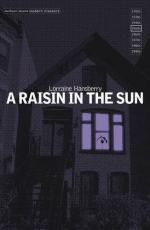|
|
A Raisin in the Sun Author/Context
Lorraine Hansberry (1930-1965)
Born and raised during the Great Depression in Chicago, Lorraine Vivian Hansberry was born into a wealthy black family. Her mother, Nannie Perry Hansberry was educated early in life and her father, Carl Augustus Hansberry, was an attorney for the NAACP and eventually became a U.S. Deputy Marshall. Since education was valued in her family and her father was a Harvard professor, she rubbed shoulders with such men as Langston Hughes, W.E.B. Dubois, Duke Ellington, and Paul Robeson. Hansberry was exposed to these intellects and talents at an early age, and used their influence to help her excel in her own interests. At age 14 and without any knowledge of the game, Hansberry won an English award for a short story about football. From that point on, she did not stop writing.
Her family moved to an all white neighborhood when Hansberry was only eight years old, after her father won a large civil rights case. Aspects of her life, such as this experience, are seen in her plays and writings. She not only studied writing at the University of Wisconsin, but she also excelled in and studied art. An avid painter, she expressed herself through two mediums, words and paints. In 1953, she married a Jewish songwriter and moved to New York City. Soon after her arrival in Greenwich Village, she wrote A Raisin in the Sun, a play inspired by a line from a Langston Hugh's poem - a man she met while writing for the magazine, Freedom. This play brought her fame as a playwright and established Sidney Poitier as the premier black actor of his time.
A Raisin in the Sun garnered much acclaim and commotion when it opened at the Barrymore Theater in New York in 1959. Not only was it the first black play ever to be produced on Broadway, but it won the New York Drama Critics Circle award for Best Play of the Year, beating out such heavyweights as Eugene O'Neill and Tennessee Williams. Compared to Arthur Miller's Death of A Salesman, Raisin elicits the similar emotions of fury and true Americanism, and is hailed as a visionary work of art.
According to New York Times drama critic Frank Rich, A Raisin in the Sun "changed American theater forever [by forcing] both blacks and white to re-examine the deferred dreams of black America [and by posing] all her concerns in a work that portrayed a black family with greater realism and complexity than had ever been previously seen on an American stage" (Carter 19).
Hansberry also wrote The Sign in Sidney Brustein's Window, a play about a Jewish intellectual. She never produced a large body of work because cancer cut short her career at the age of 35. After her death, her letters and writings were collected, published, and produced as To Be Young, Gifted, and Black, and later Les Blancs.
Bibliography
Carter, Steven R. Hansberry's Drama: Commitment amid Complexity. University of Illinois Press: Urbana, 1991.
Cheney, Anne. Lorraine Hansberry. Twayne Publishers: New York, 1994.
Hansberry, Lorraine. A Raisin in the Sun. Random House: New York, 1959.




